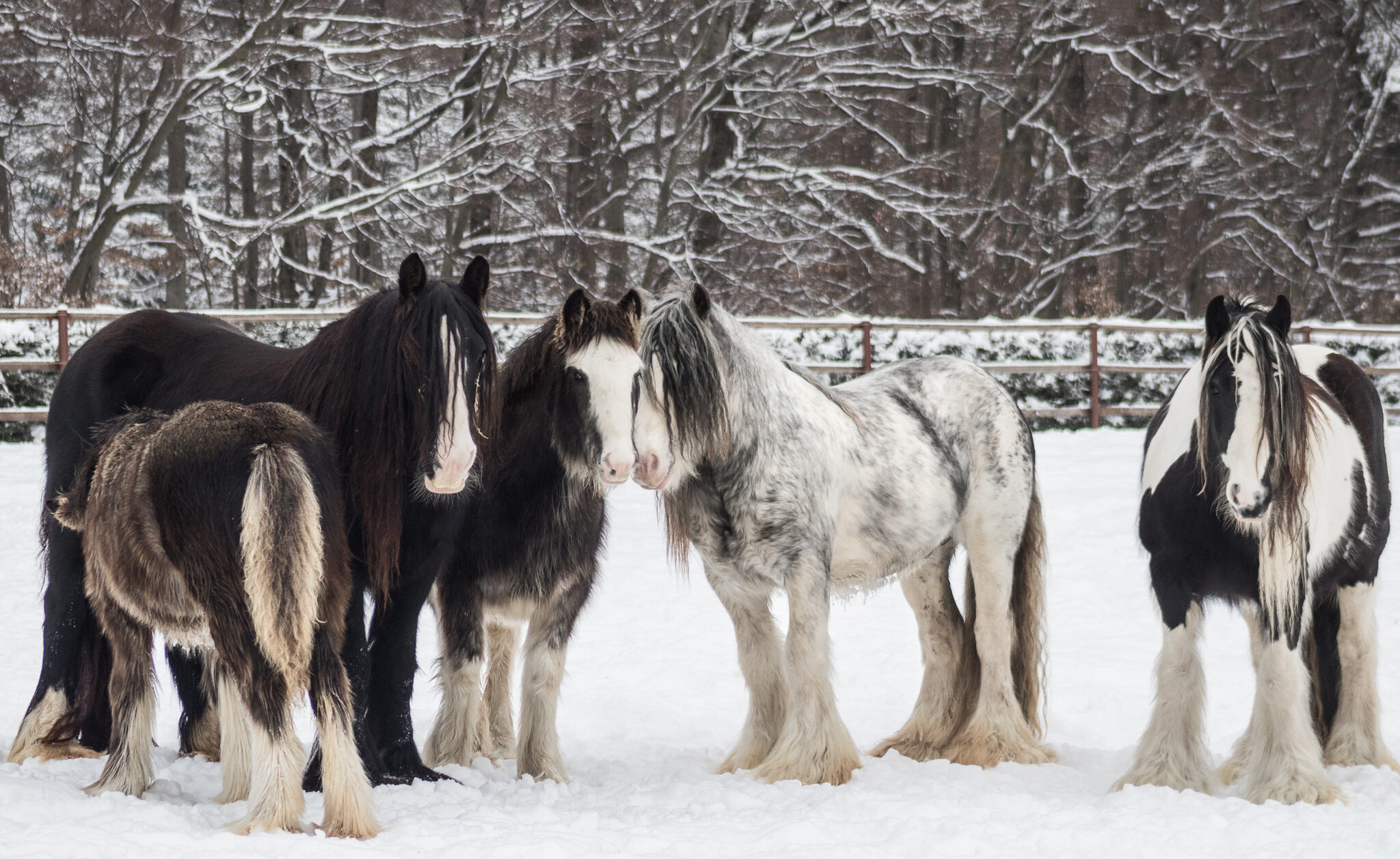Horse Breed: Irish Cob
Horse Cultures of the World
Name of breed: Irish Cob (also called the Gypsy Cob, Gypsy Vanner, Romany Tinker and Traditional Cob)
Origin: Great Britain and Ireland
Breed origin: The Irish Cob was originally bred by Irish Travellers and Great Britain’s Romani Travellers to pull the wagons in which they lived and travelled. These wagons, often known as vardoes, developed in the mid 1800s and were most widely used from the late 1800s to the 1920s. During this time, the British Roma people acquired the horses that the rest of society did not favour, many of which were coloured. Back then, it was not unheard-of for Shires to be coloured, and culling occurred to remove these genetics. Among the Roma, however, these large, strong, coloured horses became highly prized. In combination with the best of their mixed-breed stock, Clydesdales, Welsh Cobs, Fell Ponies and most importantly Dales Ponies, the Roma produced a cob-sized, big-boned, profusely feathered, colourful, good-natured wagon horse.
Meanwhile, in Ireland, a type of horse called the Irish Cob developed. It, too, was used by Travellers to pull their wagons; but it was also used for farm work, light draught work and general riding. The Irish Cob generally had a larger head, longer back and less feathering than its British counterpart, but was otherwise extremely similar. Irish Draught, Thoroughbred and Connemara bloodlines were used in its development.
Until just after World War II, the Travellers’ horse was not a breed as such, but simply a common type with bloodlines that varied from one family to the next. It was then that the idea of honing the type into a fully-fledged breed gained traction, with breeders aiming to produce ‘a small Shire, with more feather, more colour and a sweeter head’: the ideal caravan horse. Because the Romani people responsible for this selective breeding passed down the pedigrees and desired traits of their horses orally, it is now impossible to identify with any certainty who the foundation horses were.
This breed remained quite a secret until the 1990s, when it was ‘discovered’ by two Americans travelling through Great Britain. Enchanted by the horses they saw and perplexed by the lack of official recognition for the breed, they set about learning all that they could. They needed to name the breed, as it had many colloquial names but no universal one; so the name Gypsy Vanner was chosen, ‘vanner’ being the common name for a horse suitable for pulling caravans. This name is most commonly used in the US today, with other names such as Irish Cob, Gypsy Horse, Tinker and Gypsy Cob still used elsewhere. The Gypsy Vanner Horse Society was founded in 1996, and numerous other associations and societies followed as the now-official breed rapidly gained popularity. Thanks to increased freedom of movement between Ireland, Britain and the various other breeding hotspots around the world, the Gypsy Vanner (now less offensively known as the Irish Cob in most places) became a refined and recognisable breed, with exacting standards upheld worldwide.
Distinguishing features: Although many believe the Irish Cob is defined by its piebald or skewbald colouring, this is not true. All coat colours are accepted and the breed standard is only concerned with body type. Most horses stand between 13 and 16 hands high. They have a compact, muscular build, large, dense bone, a long, thick mane and tail and abundant feathering on their lower legs. Their heads are more refined than most draught breeds, with kind eyes and a broad forehead. Their strong, mid-length neck leads to a broad chest, well-rounded withers and sloping shoulders. A short, muscular back couples to well-sprung ribs and a deep girth. Like all horses bred for pulling, Irish Cobs have immensely powerful hindquarters, with a smooth, broad croup. Their legs are straight and true, with defined joints and proportionately sized hooves. Their movements are natural yet striking, with power, impulsion and flow. Irish Cobs are renowned for their gentle, loyal and willing nature. They are intelligent and sensible, as well as being extremely hardy and economical, requiring surprisingly little feed given their size.
Modern day Irish Cob: Irish Cobs are now used for all manner of disciplines. They make exceptionally good mounts for riders lacking experience or confidence, while having the intelligence and ability to take experienced riders to a high level in disciplines such as driving, hunting, English and Western pleasure and dressage. They are often used for equestrian tourism and as therapy animals due to their docile and unflappable nature. Irish Cobs are also exhibited at traditional horse shows around the world, sometimes with a beautiful caravan in tow!
References: Wikipedia, Gypsy Vanner Horse Society, Australasian Gypsy Horse Society, Gypsy Gold.
Image credits: feature image and preview image by AnetaZabranska/Shutterstock.com.




































